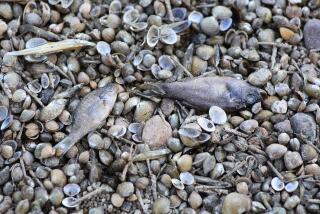Yellow sludge in Colorado river continues spread, reaches New Mexico
Reporting from Durango, Colo. — Federal officials scrambled Saturday to contain a spreading environmental disaster that began after a million gallons of contaminated water spilled from an old gold mine, flooding the Animas River and threatening crucial waterways throughout the Southwest.
The accident, caused by the Environmental Protection Agency during a cleanup operation Wednesday, triggered a toxic plume turning the beloved, crystal clear Animas the color of mustard. Some residents reportedly wept as officials shut down the river and urged people to conserve drinking water.
The fluorescent sludge, moving at 5 mph, kept going, reaching Farmington and Aztec, N.M., on Saturday as it headed for the San Juan River, Lake Powell and the Colorado River.
Portable labs for testing well water are being rushed to the Farmington area as residents, farmers and others nervously wait for answers on whether the water is safe for them and their livestock.
Unfortunately, answers were few.
In a conference call with reporters, regional heads of the EPA said the amount of water rushing from the defunct Gold King Mine, above the town of Silverton, had decreased from 740 gallons per minute to 548 gallons. And it’s now being collected in a settling pond and treated to make it less toxic.
Still, the officials said they have no idea how much water remained in the mine.
The mine water contains heavy metals, such as arsenic, lead, cadmium, aluminum and copper. Pressed on whether the river water now contains arsenic, the officials said laboratory testing wouldn’t be done for another 24 hours.
“The EPA has recognized the significance of this event and we are responding accordingly,” said Shaun McGrath, regional EPA administrator for Colorado. “Hopefully, we will get the results soon so we can understand the impact on agriculture, stock water, swimming, boating and human contact.”
He said the spill will have long-term effects as the heavy metals settle on the river bottom, then are stirred up by rain and runoff.
“We will have to do long-term monitoring and probably more closures in the future,” he said.
The accident happened Wednesday as the EPA was overseeing a cleanup crew trying to drain water from the mine into a series of holding ponds. The water surged, overwhelming the team and flooding into Cement Creek, which carried it to the Animas River, a primary source of drinking water for Durango.
In a public meeting Friday, David Ostrander, EPA’s director of emergency preparedness for the region, was contrite.
“I’m very sorry,” he told the crowd. “This is a huge tragedy.”
No one knows that better than the people of Durango, a beautiful little town framed by mountains and the once handsome 126-mile-long Animas, famed for its trout and wild rapids.
But on Saturday the usually bustling river was empty, the water a sickly yellow. No rafters, no swimmers and no one fishing for cutthroat trout. Kayaks and big red inflatable rafts sat useless in parking lots. Companies that run river tours canceled hundreds of reservations during what should be their busiest month.
“We are estimating $150,000 in lost revenue this month,” said Alex Mickel, owner of Mild to Wild, the biggest rafting company in Durango. “The EPA failed to follow their own procedures — they admitted it. Now they need to help out the community economically.”
At Riverfront Park, sadness and anger hung in the air.
“There is usually wave after wave of people floating past, but today nothing,” said Sairi Dwyer, 32, watching the yellow water roll past. “The EPA causes all of this and then they say, ‘Oh well’ and nothing happens. If you or I did this or anything close we’d be in jail.”
Downriver in Aztec, N.M., Shari Hare, who owns the Ruins Road RV Park with her husband, David, said that she had expected the plume of toxic chemicals to come downstream from Colorado, but was still taken aback by the yellow water she saw Saturday morning.
“I was shocked when I actually saw how bad it was,” said Hare, who speculated that the spill would harm tourism in the area for the rest of the summer. “This is very disheartening to the citizens of Aztec, N.M., and Durango, Colo.”
She worries that residents could be told to cut back on their water usage, which would harm her vegetable garden. She also worries about wildlife.
“The deer, geese, fox and raccoons have become somewhat like pets here,” she said.
The plume has changed color as it has advanced, fading somewhat from the bright yellow seen in Durango immediately after the spill.
“It’s kind of a, like a … I don’t know how to explain the color,” said Jason Yazzie, a student at San Juan College in Farmington. “It looks really really different. It’s really light brown.”
Jared L. McComas, a bartender in Farmington, said that he goes to the river almost every day. He was shocked by what he saw Saturday.
“It looks awful, it looks disgusting. I wouldn’t stay anywhere near the river,” he said. “Every one of my customers that comes in, I tell them not to go.”
Kelly is a special correspondent.
Times staff writer Natalie Schachar in Los Angeles contributed to this report.
Hoy: Léa esta historia en español
ALSO:
Detained immigrant mothers and children trapped in legal limbo
James Holmes is spared from death penalty in Colorado theater rampage
After a year of high-profile killings by police, Americans’ views on race have shifted
More to Read
Sign up for Essential California
The most important California stories and recommendations in your inbox every morning.
You may occasionally receive promotional content from the Los Angeles Times.










